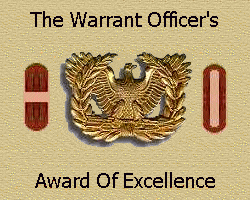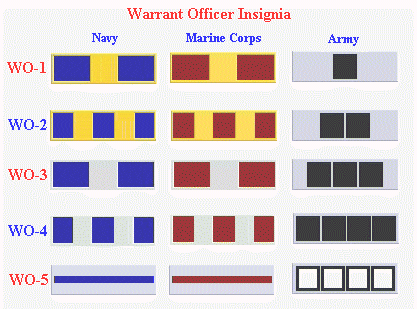|

History of the Warrant
Officer
80th Anniversary
7 July 1918 -7 July
1998

Historical Warrant Officer
Insignia
Based on the British model , the
US Navy has had warrant officers among its ranks,
in some form or another, since its conception. In the US Navy, warrant
officers have traditionally been the technical
experts whose skills and knowledge were an
essential part of the proper operation of the ship. In the US Army, the
warrant officer can be traced back to 1896,
specifically to the headquarters clerk. The
official birthday of the Army Warrant Officer Corps is 7 July 1918. During
this time warrant officers were not commissioned
officers; but in reality were considered civilians.
The Judge Advocate General later determined that warrant officers
held military status.
1918 - 1922
An act of congress in 1918 established
the Army Mine Planter Service as part of the
coastal artillery. This is when the official color of the Army Warrant
Officer Corps color came to be brown. The
color emanated from the brown stands from burlap
bags that the Mine Planter Service personnel wore as their insignia of
rank. Warrant officers served in four known
positions aboard vessels used to plant the sea
mines: masters, mates, chief engineers, and assistant engineers.
The National Defense Act of 1920
provided for warrant officers to serve in clerical,
administrative, and band leading positions. This act also authorized for
1120 warrant officers on active duty. During
this time warrant officers were excluded from
performing duties from which enlisted personnel were also excluded.
A distinctive insignia was approved
for warrant officers on 12 May 1921. It consisted
of an eagle rising with wings displayed, adapted from the great seal of
the United States. The eagle is standing on
two arrows, which symbolize the military arts
and sciences. The eagle rising is enclosed within a wreath.

1936 - 1941
In 1936, warrant officers who were
qualified pilots were declared eligible for direct
appointment to lieutenants in the Army Air Corps. This action caused a
serious decline in the warrant officer corps.
In 1941, Public law 230 authorized appointments
up to one percent of the total Regular Army enlisted strength. This law
also established two pay rates for warrant officers, Warrant Officer Junior
Grade (W1) and Chief Warrant Officer (CW2).
WO(JG) CWO
 
(W1) (CW2)
One other benefit of Public Law
230 was the authorization of flight pay for those involved
in aerial duties. In November of 1941, an executive order further extended
the Warrant Officer positions and provided the following additions:
1. Warrant Officers can be assigned as prescribed
by the Secretary of the Army. 2. When such
duties included those normally performed by commissioned officer, the
warrant officer would be vested with all the powers usually exercised by
commissioned officers in the performance of
those duties.
1942 - 1954
In November of 1942, the War Department
defined the position of the Warrant Officer
in the rank order as being above all enlisted personnel and immediately
below all commissioned officers. January 1944
saw the authorization of appointment of women
as warrant officers and by the end of WW II, forty-two female
warrant officers were serving on active duty. Warrant Officers were filling
40 different occupational specialties by early
1946 and approximately 60 specialties by 1951.
In 1948 the Career Composition Act
brought about two new pay rates for warrant officers.
The designations of Warrant Officer Junior Grade and Chief Warrant Officer
were retained, the grade of Chief Warrant Officer was provided with pay
rates of W2, W3 and W4. The Warrant Officer
Personnel Act established warrant officer
ranks W1 through W4, and officially eliminated the Mine Planter Service.
WO(JG) CWO
 
(W1) (CW2),
(CW3), (CW4)
Modern Era
It was during the 1950s, that studies
determined there was a vital need for warrant officers,
and proposed that appointment to warrant officer should be based on the
needs of the Army and simply a reward for
long and faithful service.
1957
In 1957 both changed to square-cornered
gold or silver bars with blue enamel stripes
for the Air Force and brown for the Army. There were four grades of Warrant
Officers. The Warrant Officer (W-1) wore a gold bar with two enamel stripes,
the Chief Warrant Officer (W-2) a gold bar with three stripes, the Chief
Warrant Officer (W-3) a silver bar with two
stripes and the Chief Warrant Officer (W-4)
a silver bar with three stripes. The Army found this system confusing so
in 1969 asked its Institute of Heraldry to
design another device.
On 21 January 1957, as a result
of a Department of the Army study, a new warrant
officer concept was announced and provided the following guidelines:
1. The need for warrant officers
2. The warrant officer category would not be considered a reward or incentive.
3. The first published definition for warrant
officers was established in AR 611-112 and
defined the warrant officer as follows:
"The warrant officer is a highly
skilled technician who is provided to fill those positions
above the enlisted level which are to specialized in scope to permit effective
development and continued utilization of broadly trained, branch qualified
commissioned officers."

AIR FORCE DOES NOT HAVE WARRANT
OFFICERS
NOT ALL INSIGNIAS ARE USED IN ALL THE SERVICES
WARRANT OFFICERS ARE COMMISSIONED IN SOME
OF THE SERVICES
|